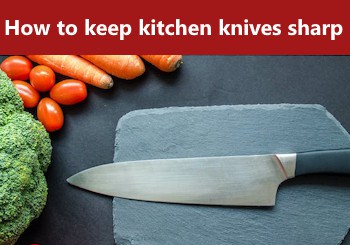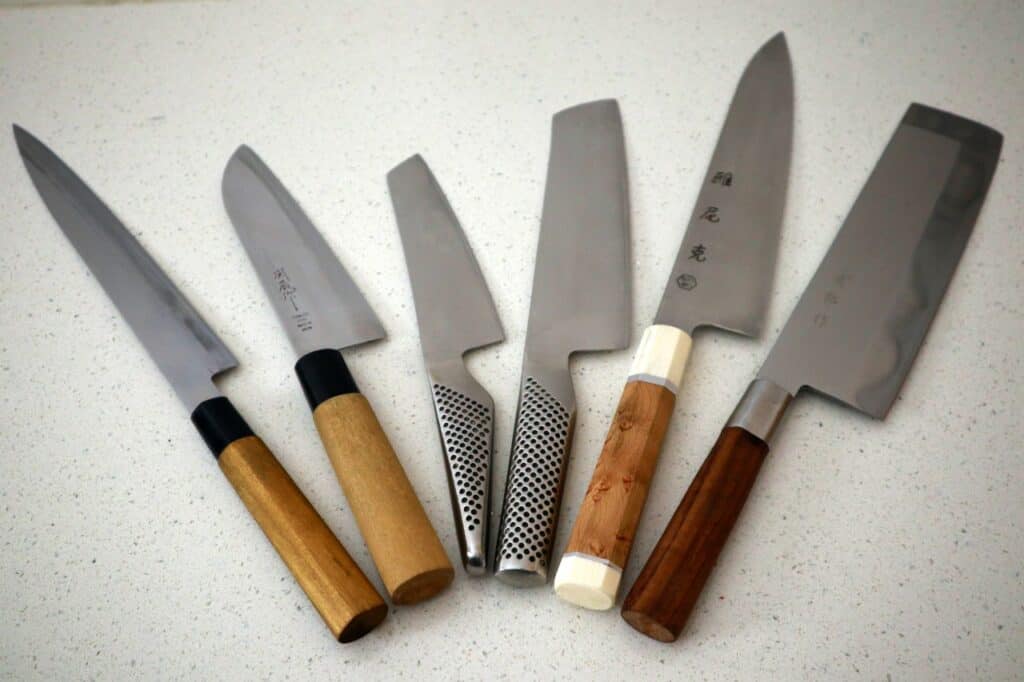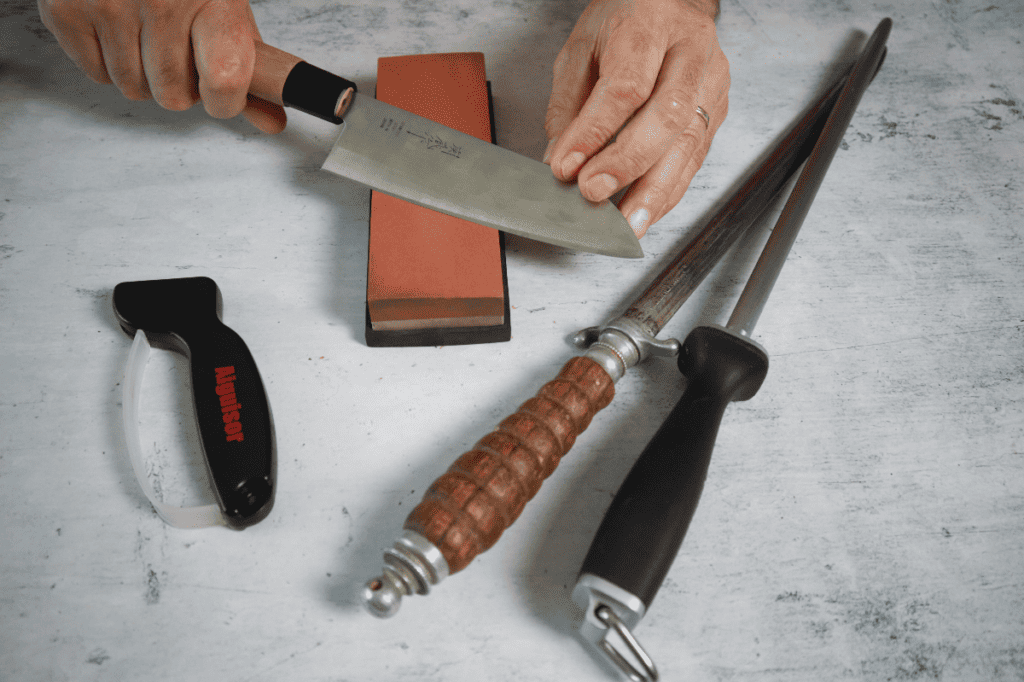How to Keep Kitchen Knives Sharp
| Mini guides to kitchen knives: Kinds of kitchen knives | Materials and construction | Storing | Sharpening | Maintaining sharpness | Rust removal | Disposal | Knife skills | Western or Japanese knives | Main kitchen knife guide |

A sharp knife is an indispensable tool in the kitchen. It is important to slice through ingredients with precision and with minimal effort while being safe at all times.
Plus, you don’t want to squash your nice food items with a dull blade!
Dull kitchen knives create frustration and therefore it is important to understand the anatomy of a knife and how to keep it maintained and sharp.
There are a few tools to sharpen knives and with our advice and tips, you will remark that it is easy to learn how to keep kitchen knives sharp for longer.
Tools to sharpen kitchen knives
Learn how to sharpen your kitchen knives effectively.
A honing rod
Although many think that a honing rod is the ultimate knife sharpener, it is a mistake. A honing rod, also known as stropping iron, is used to align the blade, which is as important as sharpening a knife. It helps straighten the metal of a knife without removing large amounts of metal from the blade.
The difficulty for a lot of people is using the rod correctly and will likely need some practice before you get it right. For good results, it is important to hold the knife in your preferred hand and the rod in the other.
While you hold the knife in a slight angle, always keep your fingers as far away from the blade as possible. Use your entire arm and move the knife along the rod from the heel to the tip of the knife. Repeat this motion a few times. Do the same on both sides of the knife.
Dedicated knife-sharpening tools
There are a multitude of sharpening tools available from whetstones to power sharpeners. We prefer sharpening our knives with a whetstone, also called water stone or sharpening stone. Such a stone has one or two sides of which one is usually rough and the other fine.
A lower, more rough grit will serve to repair the knife from eroding metal particles. A higher grit with a smoother surface is great for the polishing and finishing the knife. When sharpening a knife with the help of a whetstone, it is best to secure the stone for safe sharpening.
It is best to secure the knife with two hands at a slight angle against the stone, facing away from you and move the blade in a circular way. Always start on the rough side of the whetstone and finish on the finer side. Depending on which kind of knife is being sharpened you will only grind one side or you can alternate.

Tips to keep kitchen knives sharp
Work on the right surface
Always treat knives with respect! Working on the right surface is key in order to maintain sharpness and avoid damaging the knife.
Surfaces to avoid cutting on are concrete and metal such as stainless steel, and aluminium, because these could seriously damage the knife’s blade. We recommended using knives for cutting on plastic, polyethylene, and wood. Another way to avoid dull knives is by not scraping the knife edge along any surface.
Washing knives correctly
We have repeatedly mentioned that knives should be washed by hand! Cleaning knives in a dishwasher will make the blade dull more quickly as well as damage the handle. Washing knives by hand keeps them sharper for longer.
After cleaning knives, dry them immediately to prevent rusting. Keeping a knife wet won’t make it dull but when storing it in a knife block it might result in creating mould and bacteria.
Storing knives
Knives should always be stored in the best condition to maintain their edge. We know that many people do leave them with other kitchen utensils, but the best practice for storing knives is in a dedicated drawer or separate space. A proper knife block or a magnetic rack to hang knives will protect the blade edges and it will also keep them out of reach of children.
Best way to keep kitchen knives sharp
Knowing the best ways to keep your kitchen knives sharp will make them last longer and keep them at peak performance. In the end, you will save money, and have less food waste.
Plus, your finished recipes will look much nicer since the ingredients are cut or chopped properly. You won’t have ragged pieces nor chunks of food that are different sizes!
How long do kitchen knives last?
A good-quality, well- maintained knife should last a lifetime. It might get dull and need regular sharpening but there are reasons why knives might need replacement.
5 Reasons to replace your knives
1. The blade is chipped
When using a chef’s knife often, it will result in wear and tear with small damage. It is most important to replace a knife when the blade gets seriously chipped as this will make it difficult to cut cleanly and efficiently.
2. The knife tip is bent or broken
Breaking a knife tip is only possible when you drop it on a hard surface or use it for non-cutting purposes. We recommend using a knife only for cutting.
3. The rivets come loose
The rivets are the metal pins in the handle. It’s not a common problem, but when they come loose it’s not securing the handle is no longer secure and this changes the stability and balance of the blade which results in unsafe cutting.
4. The handle is broken or falls off
It is obvious that when a handle is broken or falls off, it is unsafe to use the knife, and a new knife is recommended.
5. The knife doesn’t feel comfortable to use
You might have made a mistake when selecting your knife or due to prolonged usage it no longer feels comfortable. Whatever the reason, a knife needs to feel like an extension of the arm and feel balanced to use at all times. If it doesn’t have the right grip or it is too big, too small or any other reason, simply replace it!
Final note on how to keep kitchen knives sharp
Maintaining the sharpness of kitchen knives is really important for efficiency and safety in food preparation. Further, honing with a steel rod can realign the edge between proper sharpenings.
Using the appropriate cutting surface, such as a wooden or plastic cutting board, will also prolong sharpness, whilst storing knives in a block or on a magnetic strip can prevent unnecessary dulling.
By combining proper technique, consistent maintenance, and mindful storage, chefs can ensure their kitchen knives remain sharp, reliable, and ready for any task, making preparation much easier.